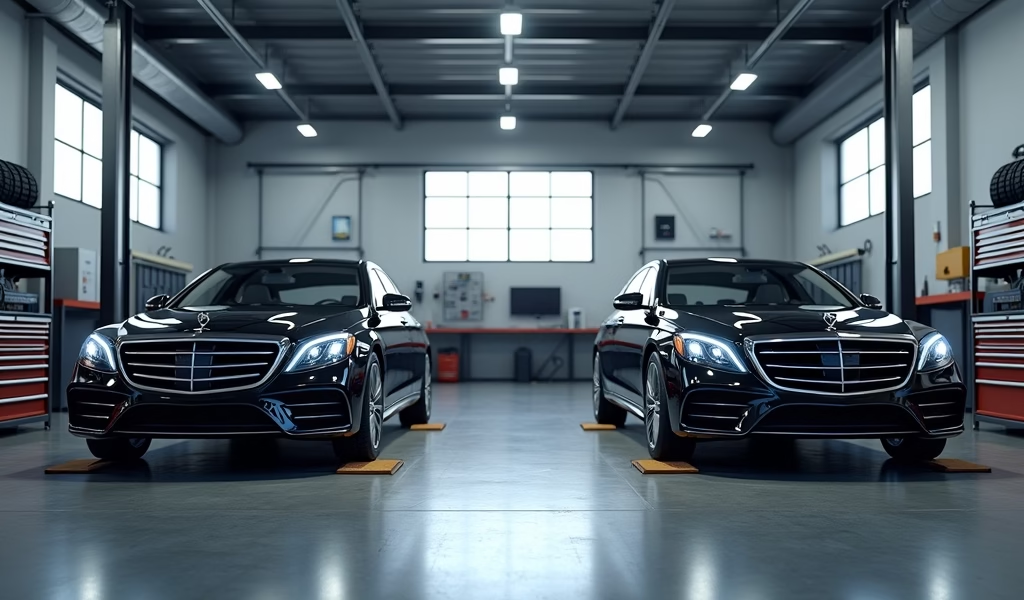Overview
This article details the key differences between Front-Wheel Drive (FWD) and All-Wheel Drive (AWD) systems, providing seven specific maintenance tips for each drivetrain type including tire rotation schedules, fluid maintenance, alignment considerations, brake system care, component inspection, seasonal adjustments, and driving habits. While AWD systems offer better traction in challenging conditions, they require more complex and costly maintenance compared to FWD vehicles, making drivetrain choice a matter of balancing performance needs against long-term maintenance expenses.
Table of Contents
- Understanding FWD vs AWD: What’s the Difference?
- Maintenance Tip #1: Proper Tire Rotation Schedules for Different Drivetrains
- Maintenance Tip #2: Essential Fluid Maintenance for FWD and AWD
- Maintenance Tip #3: Alignment Considerations by Drivetrain Type
- Maintenance Tip #4: Brake System Care Based on Your Drivetrain
- Maintenance Tip #5: Inspecting Vital Drivetrain Components
- Maintenance Tip #6: Seasonal Drivetrain Maintenance Adjustments
- Maintenance Tip #7: Driving Habits That Extend Drivetrain Life
- The Real Cost: FWD vs AWD Maintenance Expenses
- Conclusion: Getting the Most from Your Drivetrain
- Frequently Asked Questions
Understanding FWD vs AWD: What’s the Difference?
The difference between FWD and AWD isn’t just car jargon—it affects everything from how your vehicle handles to how much you’ll spend maintaining it. After 25 years under the hood, I’ve seen how understanding your drivetrain can save you thousands in preventable repairs.
Front-Wheel Drive (FWD) systems send power only to the front wheels. The engine, transmission, and differential are packaged together up front in what we mechanics call a transaxle. This setup gives you better fuel economy and more cabin space since there’s no need for components to run to the rear wheels.
All-Wheel Drive (AWD) systems, however, deliver power to all four wheels, either constantly or as needed when slippage is detected. Modern AWD systems use sophisticated electronics and mechanical components that continuously monitor traction and adjust power accordingly.
One misconception I hear in the shop almost weekly: “My AWD makes me invincible in snow.” While AWD certainly improves traction in challenging conditions, it doesn’t help you stop any faster. And contrary to popular belief, most FWD vehicles handle day-to-day driving situations just fine—many drivers never tap into the capabilities that make AWD worth the extra maintenance.

Maintenance Tip #1: Proper Tire Rotation Schedules for Different Drivetrains
Tire rotation isn’t just about getting your money’s worth from rubber—it’s essential for drivetrain health. Your rotation pattern and frequency should differ based on whether you’re driving FWD or AWD.
For FWD vehicles, the front tires handle a triple workload: steering, accelerating, and most of your braking. This causes them to wear faster than rear tires. I recommend a forward cross pattern rotation every 5,000-7,000 miles, where front tires move to the opposite rear positions while rear tires move straight forward.
AWD vehicles tend to wear tires more evenly since all four are engaged in driving, but regular rotation is still crucial. For most AWD systems, aim for rotation every 5,000 miles using a complete cross pattern. This helps ensure even wear across all tires—critical because uneven tire wear can strain your AWD system as it tries to compensate for different wheel speeds.
Warning signs that you’ve waited too long include uneven tread wear (especially on the inside or outside edges), vibration at highway speeds, or your car pulling to one side. Choosing the right tires initially can also help extend their lifespan, regardless of your drivetrain configuration.
I’ve seen neglected rotation schedules lead to premature drivetrain component failure. One customer with an AWD crossover saved $60 by skipping rotations, only to need a $1,200 transfer case repair when his mismatched tire sizes overstressed the system.
Maintenance Tip #2: Essential Fluid Maintenance for FWD and AWD
Think of drivetrain fluids as your vehicle’s lifeblood—they lubricate, cool, and protect critical components. The fluid maintenance requirements differ significantly between FWD and AWD systems.
For FWD vehicles, you’re primarily dealing with transmission fluid, which serves double duty by lubricating both the transmission and differential components within the transaxle. Most manufacturers recommend changing this fluid every 30,000-60,000 miles. The color should be red or light brown—if it’s dark or smells burnt, don’t wait for the scheduled change.
AWD systems require more comprehensive fluid maintenance. You’ll need to monitor:
- Transmission fluid
- Front differential fluid
- Rear differential fluid
- Transfer case fluid (in many systems)
Each of these fluids typically needs changing every 30,000-50,000 miles, but check your owner’s manual for specifics. Different AWD designs (like Subaru’s symmetrical AWD versus Audi’s quattro) have different maintenance requirements. As a certified ASE master technician, I’ve repaired countless AWD systems where owners followed generic advice rather than vehicle-specific guidelines.
Many newer vehicles have “lifetime” or sealed fluid systems. Don’t be fooled—”lifetime” often means the lifetime of the warranty, not the vehicle. For these systems, I still recommend fluid services every 60,000 miles to maximize component life.
Maintenance Tip #3: Alignment Considerations by Drivetrain Type
Proper wheel alignment affects both drivetrain types differently, but it’s essential for maximizing component life regardless of which system powers your vehicle.
For FWD vehicles, misalignment primarily impacts the front wheels, which already handle the bulk of your vehicle’s work. When alignment is off, the additional strain on CV joints, bearings, and steering components accelerates wear dramatically. I’ve seen FWD vehicles with alignment issues burn through front tires in less than 15,000 miles while simultaneously damaging expensive drivetrain components.
AWD vehicles face a different challenge: misalignment can cause the entire drivetrain to work harder as the system constantly compensates for wheels that want to track in slightly different directions. This puts extra stress on differentials, the transfer case, and other AWD components. The torque distribution electronics in modern AWD systems try to correct these issues, potentially masking the problem until significant damage occurs.
For both drivetrain types, I recommend checking alignment annually or whenever you experience symptoms like pulling to one side, uneven tire wear patterns, or a steering wheel that’s not centered when driving straight. Always check alignment after hitting significant potholes or curbs—damage doesn’t always show immediate symptoms.
A quality alignment check costs around $100, but can save thousands in premature tire and drivetrain component replacement. It’s one of the most overlooked but valuable preventive maintenance services for protecting your drivetrain.
Maintenance Tip #4: Brake System Care Based on Your Drivetrain
Your drivetrain configuration directly influences how your braking system wears, and understanding this relationship helps you anticipate maintenance needs before they become costly problems.
With FWD vehicles, approximately 70% of braking force occurs at the front wheels. This front-heavy braking profile means front brake pads and rotors typically wear at nearly twice the rate of rear components. I regularly see FWD vehicles that need front brake service at 30,000-40,000 miles, while rear brakes might last 60,000-70,000 miles or more.
AWD vehicles distribute weight more evenly, but front brakes still handle the majority of stopping power. The difference is smaller, with front brakes typically lasting about 40,000-50,000 miles compared to rear brakes at 60,000-70,000 miles. Some sophisticated AWD systems with advanced stability control actually influence brake wear patterns through their torque distribution and traction control programming.
For both drivetrain types, listen for squealing, grinding, or vibration during braking—these indicate brake system issues that should be addressed promptly. Remember that while AWD improves traction and stability, it doesn’t improve stopping distance, which depends primarily on tire grip and brake system condition.
One maintenance tip I share with all my customers: regardless of drivetrain type, flush your brake fluid every 2-3 years. Brake fluid absorbs moisture over time, lowering its boiling point and reducing braking performance. This service costs relatively little but significantly extends the life of expensive brake system components while maintaining safety.

Maintenance Tip #5: Inspecting Vital Drivetrain Components
Each drivetrain type has its own set of critical components that need regular inspection to prevent major repairs. Knowing what to look for can help you catch problems before they escalate into expensive failures.
For FWD vehicles, the constant velocity (CV) joints and axles deserve special attention. These components transfer power from the transmission to your wheels while accommodating suspension movement and steering angles. Signs of failing CV joints include clicking noises when turning, especially during sharp turns, or visible grease on the inside edge of your tires from a torn boot.
I recommend having these components inspected during each oil change. A torn CV boot caught early might cost $150-300 to replace, while waiting until the joint fails completely can run $500-800 per side.
AWD vehicles have all the same vulnerable components as FWD, plus additional items to monitor:
- Transfer case integrity (listen for unusual noises or grinding)
- Center differential functioning (vibrations or binding during turns)
- Rear differential condition (leaks or whining noises)
- Driveshaft and universal joints (clunking or vibration during acceleration)
For both drivetrain types, unusual vibrations, clunking sounds when shifting, or difficulty turning can indicate serious issues requiring immediate attention. One inspection technique I teach my apprentice mechanics: place your hand on components (when safe and cool) while someone else slowly accelerates the vehicle. You’ll often feel problems you can’t yet hear.
Research from the NHTSA shows that regular inspections can identify up to 85% of potential drivetrain failures before they cause roadside breakdowns. That five-minute inspection during routine service can save you thousands in towing and emergency repair costs.
Maintenance Tip #6: Seasonal Drivetrain Maintenance Adjustments
Your maintenance schedule should adapt with the seasons, especially if you live in an area with significant temperature variations. What works for your drivetrain in July might not be ideal in January.
For winter preparation in FWD vehicles, winter tires make a substantial difference since your drive wheels are also your steering wheels. The rubber compounds in winter tires stay pliable at lower temperatures, providing crucial grip. Consider having your transmission fluid checked before winter sets in—cold weather can expose weaknesses in aging fluid that summer driving masks.
AWD vehicles benefit from similar winter preparations, but with additional attention to transfer case and differential fluids. While AWD provides superior winter traction, winter tires are still essential—AWD helps you go in snow, but it doesn’t help you stop any better than a two-wheel drive vehicle with the same tires.
Summer brings its own considerations. Heat accelerates fluid breakdown, particularly in AWD systems where multiple drivetrain components generate heat. If you live in areas with temperatures regularly exceeding 90°F, consider shortening your fluid change intervals by about 20%. During summer months, I also recommend more frequent undercarriage rinses to remove corrosive road salts and debris that can damage drivetrain components.
Climate factors like humidity, salt exposure, and temperature extremes affect maintenance schedules regardless of drivetrain type. I’ve seen firsthand how vehicles in coastal areas or regions with heavy snow (and road salt) require more vigilant inspection and protective treatments. Many of the best cars for 2025 now include improved undercoating specifically designed to protect drivetrain components from these environmental factors.
Maintenance Tip #7: Driving Habits That Extend Drivetrain Life
How you drive has a profound impact on drivetrain longevity, often more significant than adherence to maintenance schedules. Simple adjustments to your driving habits can add years to your drivetrain’s service life.
For FWD vehicles, avoid aggressive starts that cause wheel spin. This puts tremendous strain on CV joints and can damage them over time. When parking, turn the wheels before coming to a complete stop to reduce stress on power steering components. Be gentle when navigating speed bumps or driveway entrances—coming in at an angle reduces impact forces on your drivetrain.
AWD vehicle owners should avoid mixing tire brands, models, or tread depths. Even small differences force AWD systems to compensate for rotation differences, creating heat and wear. Limit extended high-speed driving through deep water, mud, or sand, which can overheat differentials. If you do get stuck, avoid the “rocking” technique for more than brief periods—this generates excessive heat in drivetrain components.
For both drivetrain types, let your vehicle warm up for 30-60 seconds before driving (longer in very cold weather), which allows drivetrain fluids to circulate properly. Avoid extended idling in “Drive” with the brake applied, as this creates unnecessary heat in transmission fluid. And perhaps most importantly, drive smoothly—progressive acceleration and braking reduces stress on every drivetrain component.
One of my longtime customers has put over 300,000 miles on her AWD wagon with only routine maintenance. Her secret? She drives like there’s an egg between her foot and the pedals—smooth inputs that minimize drivetrain stress.
The Real Cost: FWD vs AWD Maintenance Expenses
Let’s talk dollars and cents. From decades in the service bay, I can tell you that FWD systems generally cost less to maintain over the life of a vehicle—there’s just less that can go wrong.
FWD maintenance costs benefit from a simpler design with fewer components. Generally, FWD vehicles require less frequent fluid services since there are fewer fluids to change. When major drivetrain repairs become necessary, they’re typically 15-25% less expensive than equivalent AWD repairs. A typical CV axle replacement on a FWD vehicle might cost $250-400, while similar repairs on AWD vehicles often run $350-550 per axle.
AWD maintenance costs reflect the system’s complexity. More components mean more potential failure points and more fluids to maintain. While some owners balk at the additional expense, many find the performance benefits worth the investment. The used car market tends to agree, as AWD vehicles often command higher resale values, which can offset some maintenance expenses over time.
AWD maintenance makes financial sense for drivers who:
- Regularly drive in snow, ice, or off-road conditions
- Need maximum traction for safety concerns
- Use their vehicle for towing or hauling
From my experience, the average AWD vehicle costs approximately $750-1,200 more in maintenance over a 100,000-mile lifespan compared to an equivalent FWD model. Is that worth it? That depends entirely on your driving needs and conditions.
Conclusion: Getting the Most from Your Drivetrain
Whether you’re driving FWD or AWD, following your manufacturer’s recommended maintenance schedule remains the foundation of drivetrain longevity. Beyond that, the key takeaways from my decades in the repair bay are:
- Rotate your tires according to the pattern and schedule appropriate for your drivetrain
- Stay vigilant with fluid maintenance—especially for complex AWD systems
- Address alignment issues promptly to prevent cascading drivetrain damage
- Understand how your drivetrain affects brake wear patterns and plan accordingly
- Listen for warning sounds specific to your drivetrain type
- Adapt maintenance for seasonal changes
- Drive smoothly to minimize drivetrain stress
The differences between FWD and AWD systems matter not just for performance, but for longevity and maintenance costs. By understanding your vehicle’s specific needs, you’re taking control of your automotive future—reducing unexpected repairs, saving money, and extending the life of your vehicle.
Remember, the most expensive repairs are almost always the ones that could have been prevented with proper maintenance. Whether you’re navigating city streets in your efficient FWD commuter or tackling back country roads in your capable AWD crossover, these maintenance principles will keep you rolling for hundreds of thousands of miles.
Frequently Asked Questions
Is AWD worth the extra maintenance cost?
For drivers who regularly face snow, ice, or unpaved roads, the extra traction of AWD justifies the additional maintenance expenses. For predominantly city or highway driving in mild climates, FWD is often more economical.
Do AWD vehicles get worse gas mileage?
Yes, AWD systems typically reduce fuel economy by 1-3 MPG compared to FWD equivalents due to the additional weight and friction of powering all four wheels. Modern AWD systems with part-time operation have narrowed this gap somewhat.
Can I rotate my own tires on an AWD vehicle?
Yes, you can rotate tires on an AWD vehicle yourself, but ensure you follow the correct rotation pattern (usually a complete cross pattern) and maintain equal tire pressure afterward. Always torque lug nuts to manufacturer specifications.
Will AWD help me stop faster in snow?
No, AWD only helps with acceleration and stability, not stopping distance. Braking performance in snow depends primarily on tire type and condition, not drivetrain configuration.
How often should differential fluid be changed in an AWD vehicle?
Most manufacturers recommend changing differential fluids every 30,000-60,000 miles in AWD vehicles. Severe driving conditions (towing, off-road use, extreme temperatures) may require more frequent service intervals.

